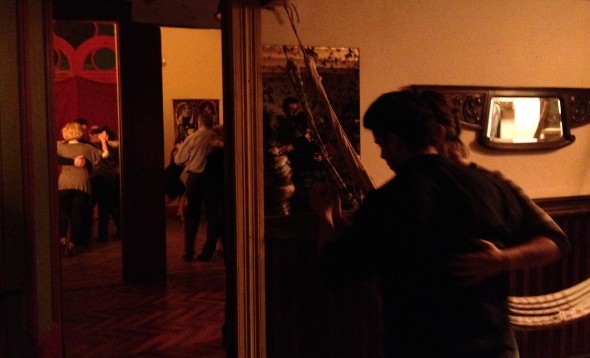A Walk Through Buenos Aires: Learning The Tango
‘Just walk,’ is what they told me. ‘It’s easy. You’re walking from one place to another.’ I had just landed earlier that morning at the Ezeiza International Airport in Argentina’s capital of Buenos Aires, and less than eight hours later, I was at the feet of tango instructors Ines Rossetti and Fernando Bietti learning the dance of the people of this city. My very first milonga or ‘tango party’ was at Zona Tango Milonga, an intimate setting commencing with a lesson of only eight dancers. The space was familiar, a bit cold at first, made up of smaller rooms with antique furniture and weathered wood flooring. It was dark, and the lesson had begun with us walking forward and backward; it was a stylized walk based on movement we do every day of our lives. That’s all it needed to be. My instructor, Ines, is a sweet, twenty-something whose young face and genuine smile put me immediately as ease. She and I had been in contact via email for almost a month through a mutual friend-of-a-friend, so our first encounter included the traditional kiss on the cheek followed immediately by an introduction to her teaching partner, Fernando. He was an older gentleman in burlap pants and comfortable shoes, and was the owner and organizer of the Zona Tango Milonga (which I later found out was his home). My first impression of this place was its quasi-secretive atmosphere; the address lead me to an open door on a quiet, semi-industrial street with a stairway lit like a corridor in the red light district. Fernando initially was skeptical of my intentions in his home; could I blame him? I had arrived with my camera crew hoping to film such an intimate moment; my goal was to document a week’s worth of tango in Buenos Aires from all views, including the commercialized Festival Y Mundial de Tango (International Tango Festival) happening the last two weeks of August, the local milongas, and the highly stylized tango productions like Tango Porteño. I was an interloper with a camera following my every move, a boom mic, and some extra lighting that floated along for the ride.
With some coaxing and small talk, Fernando agreed to let me film my first lesson in Buenos Aires. And so it began. Like I said, we started walking. Walking forward, always keeping balance, projecting one foot in front of the other only slightly further than a normal gait. I would try and swoosh my feet together as I shifted weight to my other leg; another reach, and out went my opposite foot. ‘Don’t think about it, just walk,’ Ines added. She immediately took my hands to lead me and my rhythm locked in with her pace. There was this uncanny way that Ines transferred her effortless movements to whomever she was with; for the rest of my six days following, I would consider Ines my ‘Tango Guardian Angel.’ Though I had only taken a handful of tango lessons in the past, I was quickly thrown into a full-on dance, following the direction of my well-versed partners. Fernando kept a close eye on me, and I think at some point, he realized my true intentions; that I was not there to exploit him but to genuinely immerse myself in the culture and learn as much as I could in the limited amount of time that I had.
The three-minute classic tango song ended, and partners were exchanged. Under the direction of Ines and Fernando, we were assigned different partners based on what they thought we each needed fixing. Fernando then offered his hand to me, and I would by lying if I said I wasn’t nervous. The violins began to swell from the speakers in the doorway and we entered in an embrace, preparing for the next tango. My body began to sway with his, and very slightly I began to feel his direction to shift my weight from right to left. He initiated a step, and soon we were moving in unison, slowly and steady around the room. My anxiety with dancing with him began to subside, and my shoulders relaxed; I began to breath and Fernando’s embrace became tighter. Soon, our faces were touching and we were dancing together in a way that I had never felt before: the energy being passed between our bodies was electrifying, fueling our movements in the small space. I could not see what we were doing, but I could feel the movements being told to me through his gestures. When the music came to its dramatic close, I was completely winded, not because I was fatigued or worn out; on the contrary, I had just been revived from my state of normalcy with my endorphins kicking in, and my body had tasted a new drug. ‘It’s the Tango Virus…it happens,’ I was told later by another dancer. ‘There’s a reason why people all over the world leave their everyday lives, their jobs, there homes to live in Buenos Aires and study tango.’
 Towards the end of the lesson, people of all walks of life began to slowly trickle in the doorway, finding a spot on a worn-out Victorian couch or a piano bench, all waiting for the milonga to begin. Couples filled the rooms, dancing intensely with each other, while others ordered empanadas and bottles of Quilmés from the make-shift café out of Fernando’s kitchen. The outdoor patio was filled with smokers getting in their cigarette fix before heading back into the living room or the foyer or whichever room was available to share some space with another dancer. I sat with Fernando and Ines, asking them about this special place, and from what I could understand, this was not your typical milonga. This was a place of openness and community, a place to share ideas and to be inspired. The traditional attitude of the man leading a woman, not just in tango, is thrown out the door, and a sense of equality in improvisational input in the choreography is promoted. It was like a socialist tango commune.
Towards the end of the lesson, people of all walks of life began to slowly trickle in the doorway, finding a spot on a worn-out Victorian couch or a piano bench, all waiting for the milonga to begin. Couples filled the rooms, dancing intensely with each other, while others ordered empanadas and bottles of Quilmés from the make-shift café out of Fernando’s kitchen. The outdoor patio was filled with smokers getting in their cigarette fix before heading back into the living room or the foyer or whichever room was available to share some space with another dancer. I sat with Fernando and Ines, asking them about this special place, and from what I could understand, this was not your typical milonga. This was a place of openness and community, a place to share ideas and to be inspired. The traditional attitude of the man leading a woman, not just in tango, is thrown out the door, and a sense of equality in improvisational input in the choreography is promoted. It was like a socialist tango commune.
The rest of the evening was just as magical with a live tango trio performing (upright bass, piano, and bandoneon), occasionally accompanying a passionate tenor voice. This was my first taste of tango, and I was hooked. What I felt when I danced with Fernando wasn’t just a dance; it was a conversation between two strangers that quickly ignited a new friendship and new sense of awareness in myself. In the past six days, as I think back on my entire trip, my most memorable moment was when my body awoke from its dormant state pre-tango. Gracias, Zona Tango and Buenos Aires, for the wake-up call.
Catch my tango adventures in the Bare Feet™ Web Series NOW!
 The Bare Feet™ Five:
The Bare Feet™ Five:
1. Zona Tango: Zona Tango is a weekly milonga held every Wednesday, beginning with a lesson at 8:30pm. The actual milonga starts around 10:30pm and usually goes until 3am. Venezuela St. 2941, Buenos Aires, Argentina, 20 pesos per person.
2. Ines Rossetti: Rossetti has dedicated her life to studying all aspects of tango, including starting a collective with two of her childhood dance friends, Tango Abrancancha which literally means open field. Their belief is that tango is an open art form, to be shared by all, and to be equal to all for both roles as men and women.
3. Tango Festival: This year’s 10th Festival y Mundial de Tango continues through August 28th, 2012 with special events and performances, master classes, exhibitions, competitions, and more! Be sure to make a trip to if you are in Buenos Aires – it’s FREE and open to the public!
4. Tango Porteño: Tango has become a huge tourist attraction in Buenos Aires, and a spectacular example of show-stopping music and dance is at Tango Porteño, a dinner theater show that transports the audience to the hay day of Tango during the 1920’s and 1930’s. A tango lesson is offered to the audience prior to every show, so arrive early! Tango Porteño, Cerrito 570, Buenos Aires +54 11 4124-9400
5. More Milongas: There are endless milongas happening every night in Buenos Aires; some of my favorites besides Zona Tango include La Glorieta (outdoor milonga in a giant gazebo), Cochabamba 444 (a mixed crowd of traditional and informal tango etiquette) and my absolute favorite, La Catedral de Tango (live music and special art performances included!).
Thank you to our sponsors! Design Suites and Borello Travel & Tours partially sponsored this Argentina adventure! The Design Suites line of hotels is a perfect balance with Buenos Aires lifestyle and convenience - centrally located in the heart of the distinguished Recoleta neighborhood, this hotel is part of a family hotels throughout Argentina known for their simple elegance. Borello Travel & Tours specializes in South American travel experiences and offer the true, authentic feel in their destinations. To book travel, go to www.BorelloTravel.com or call (212) 686-4911.
